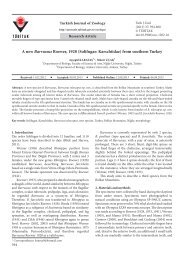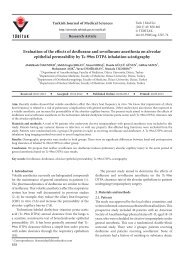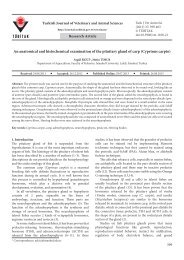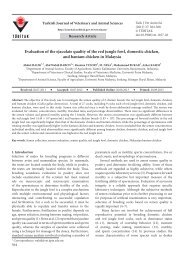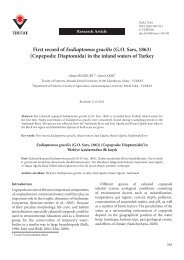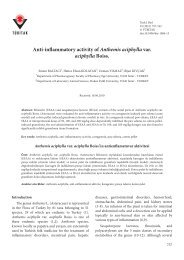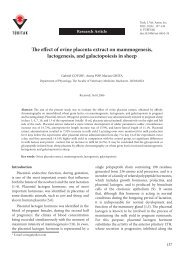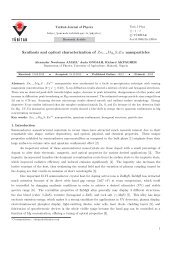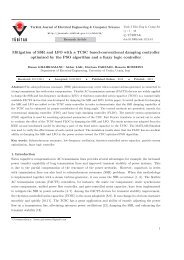Preliminary study on Acropora - Scientific Journals - Tübitak
Preliminary study on Acropora - Scientific Journals - Tübitak
Preliminary study on Acropora - Scientific Journals - Tübitak
You also want an ePaper? Increase the reach of your titles
YUMPU automatically turns print PDFs into web optimized ePapers that Google loves.
(26°14′N–26°19′N, 54°29′E–54°32′E), and Khark Island<br />
(29°12′N–29°16′N, 50°16′E–50°20′E), from the eastern,<br />
central, and western parts of the Persian Gulf, respectively.<br />
Al<strong>on</strong>g the coasts of these 3 islands, 40 locati<strong>on</strong>s<br />
were selected (Figure 1) for sampling. The geographic<br />
coordinates of each stati<strong>on</strong> were obtained using a Garmin<br />
Etrex GPS receiver. From the 1169 col<strong>on</strong>ies, pieces of 10<br />
to 15 cm were collected from October 2008 to December<br />
2009. The first author carried out the underwater<br />
photography. At each stati<strong>on</strong>, the specimens were collected<br />
by scuba diving to the depths of 3, 6, and 9 m, al<strong>on</strong>g a line<br />
at least 120 m l<strong>on</strong>g.<br />
c b<br />
30°<br />
28°<br />
26°<br />
2 km 2 km<br />
IRAQ<br />
KUWAIT<br />
Khark<br />
SAUDI ARABIA<br />
N<br />
W E<br />
S<br />
Khark<br />
Farsi<br />
RAHMANI and RAHIMIAN / Turk J Zool<br />
BAHRAIN<br />
Bushehr<br />
Farur<br />
Persian Gulf<br />
The specimens were bleached in 5 ppt sodium<br />
hypochlorite and transferred to the laboratory where<br />
further studies took place. To <str<strong>on</strong>g>study</str<strong>on</strong>g> the gross and fine<br />
morphologies of the specimens, a Nik<strong>on</strong> SMZ 1000<br />
stereomicroscope and a Zeiss DSM960A scanning electr<strong>on</strong><br />
microscope were used, respectively. Based <strong>on</strong> even minute<br />
morphological differences, 55 specimens representing<br />
9 species (excluding <strong>Acropora</strong> aspera) were selected<br />
and shipped to the Museum of Tropical Queensland for<br />
further studies and identificati<strong>on</strong>s. Of these specimens,<br />
C.C. Wallace identified 45. Mostly due to their small size,<br />
10 specimens remained unidentified. The morphological<br />
N<br />
W E<br />
S<br />
IRAN<br />
Larak<br />
0 200km<br />
QATAR<br />
U.A.E.<br />
48° 50° 52° 54° 56°<br />
TIR<br />
N<br />
W E<br />
S<br />
Bandar Abbas<br />
Hormuz<br />
Lavan<br />
Larak<br />
Hendourabi<br />
Hengam<br />
Kish<br />
FarurT<strong>on</strong>be-e<br />
Bozorg<br />
T<strong>on</strong>be-e Kouchak<br />
Farurgan<br />
SirriAbu Musa<br />
Qeshm<br />
OMAN<br />
Figure 1. Sampling sites in the Persian Gulf al<strong>on</strong>g the coasts of a) Larak Island, b) Farur Island, and c) Khark Island.<br />
a<br />
N<br />
W E<br />
S<br />
2 km<br />
309



